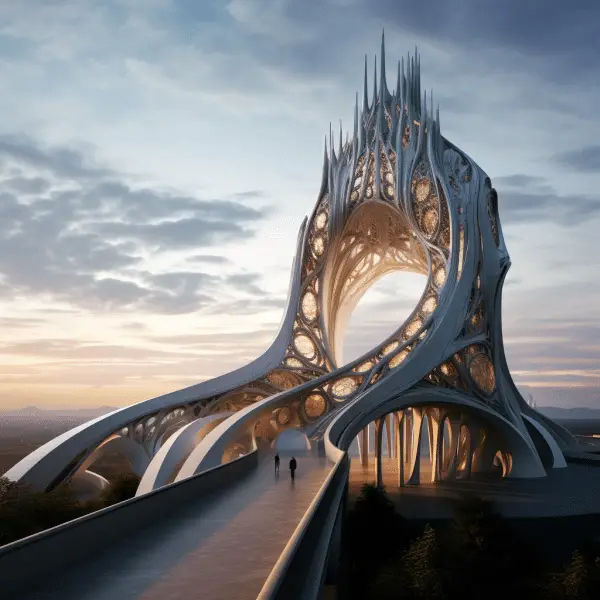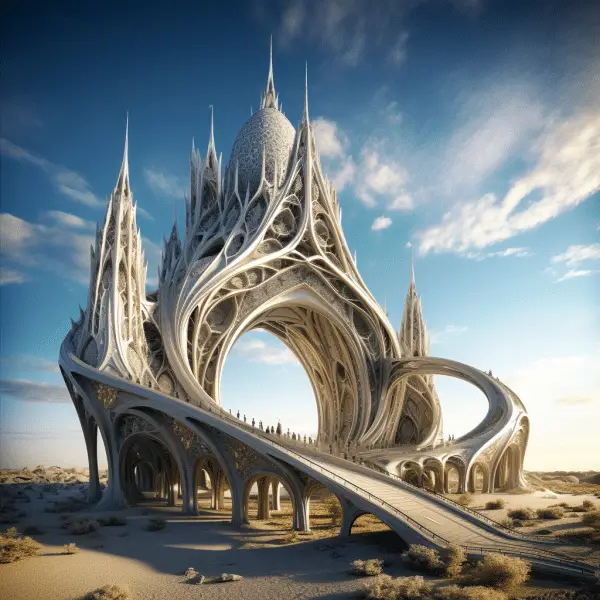Architectural Marvels: From Ancient Wonders to Modern Innovations
Iconic Architectural Designs captivate the world with their timeless beauty and innovative designs. From ancient wonders to modern marvels, these architectural masterpieces showcase the brilliance and creativity of human ingenuity. Let’s explore some of the most renowned architectural designs that have left an indelible mark on history and continue to inspire awe and admiration.
Key Takeaways:
- Hagia Sophia in Istanbul, Turkey, is a remarkable architectural marvel with rich historical significance.
- The Guggenheim Museum in New York City, USA, is known for its revolutionary design and architectural innovation.
- The Taj Mahal in Agra, India, is an enchanting symbol of architectural beauty and Indian heritage.
- The Dancing House in Prague, Czech Republic, showcases unique architecture and artistic freedom.
- Château de Chenonceau in Chenonceaux, France, exemplifies the elegance and grandeur of the French Renaissance.
These iconic architectural designs represent the diversity of cultures and architectural styles around the world. Each structure tells a story, reflecting the history, art, and ingenuity of the civilizations that created them. Whether you appreciate the ancient wonders of the Pyramids of Giza or the modern innovation of the Guggenheim Museum, these architectural designs stand as testaments to the human desire for beauty and expression.
The Hagia Sophia in Istanbul, Turkey
The Hagia Sophia in Istanbul is a magnificent structure that showcases a blend of Byzantine and Ottoman architectural styles. Its grand dome, intricate mosaics, and towering minarets attract millions of visitors each year. The dome, which measures around 31 meters in diameter, was a groundbreaking engineering feat for its time. Today, the Hagia Sophia serves as a museum and symbol of Istanbul’s rich history and cultural heritage. Visitors can explore its vast interior filled with intricate mosaics, soaring columns, and historical artifacts. Its architectural beauty and historical significance have earned it a place among the world’s most famous designs.

The Guggenheim Museum in New York City, USA
The Guggenheim Museum in New York City, USA, is an architectural masterpiece that redefines the concept of a museum. Designed by the legendary architect Frank Lloyd Wright, this iconic structure stands as a testament to his innovative vision and unparalleled creativity.
With its distinctive spiral shape and unconventional design, the Guggenheim Museum is a sight to behold. Its unique form allows visitors to embark on a continuous journey of discovery as they navigate the museum’s interconnected galleries. The open interior space and curved walls create a sense of fluidity, blurring the boundaries between art and architecture.
Architectural Innovation
One of the most notable features of the Guggenheim Museum is its innovative use of space. Unlike traditional museums with separate rooms and corridors, Wright’s design revolutionized the way we experience art. The continuous spiral ramp provides a seamless flow and encourages visitors to explore the artwork in a non-linear fashion.
Wright’s vision for the Guggenheim Museum aimed to break away from the conventional box-like structures of museums at the time. His bold and forward-thinking approach challenged the norms of architectural design, creating a space that not only houses artwork but also becomes a work of art in itself.
| Architect | Location | Year Built |
|---|---|---|
| Frank Lloyd Wright | New York City, USA | 1959 |
The Guggenheim Museum stands as a testament to the power of architectural innovation and its ability to reshape our perception of space. Its timeless design continues to inspire and captivate visitors from around the world, solidifying its status as one of the most remarkable architectural achievements of the 20th century.
The Taj Mahal in Agra, India
The Taj Mahal in Agra, India is an iconic structure that captures the hearts of all who visit. It was built in the 17th century as a symbol of Emperor Shah Jahan’s love for his wife, Mumtaz Mahal. The Taj Mahal’s stunning white marble façade, with intricate carvings and inlaid precious stones, is a masterpiece of Mughal architecture. Visitors can explore the intricate marble work and beautiful arched passages inside the mausoleum. The Taj Mahal’s beauty is further enhanced by its stunning surroundings, including the charbagh and reflecting pool that creates a mesmerizing mirror image of the main structure.
The Taj Mahal is a famous building that people love to visit. It’s beautiful at dawn or when the moon is shining. It’s considered one of the most amazing architectural wonders in the world and is remembered by everyone who visits.
| Architectural Style | Architect | Construction Period |
|---|---|---|
| Mughal | Ustad Ahmad Lahauri | 1632-1653 |
The Dancing House in Prague, Czech Republic
The Dancing House in Prague, Czech Republic, breaks the mold with its whimsical and innovative architectural design. Designed by architect duo Vlado Milunić and Frank Gehry, the Dancing House stands out amidst the historic and traditional buildings of Prague. Completed in 1996, this iconic structure has become a symbol of artistic freedom in the city.
The unique design of the Dancing House draws inspiration from the dynamic and fluid movements of a dancing couple. Its curvaceous and asymmetrical shape challenges traditional architectural norms, creating an avant-garde masterpiece. The building features a glass tower and a concrete structure, harmoniously blending different materials to create a visually striking composition.
Inside the Dancing House, visitors can find the Ginger & Fred Restaurant, named after the legendary dance partners Ginger Rogers and Fred Astaire. The restaurant offers stunning panoramic views of Prague’s skyline, allowing guests to dine in style while admiring the city’s beauty. It is a popular destination for both locals and tourists seeking a unique dining experience.
| Architect | Year Completed | Location |
|---|---|---|
| Vlado Milunić and Frank Gehry | 1996 | Prague, Czech Republic |
The Dancing House has become an architectural landmark and a must-visit attraction for those exploring Prague. Its distinctive design and innovative approach to architecture have earned it international recognition, solidifying its place among the most famous architectural designs in the world.
Château de Chenonceau in Chenonceaux, France
Château de Chenonceau in Chenonceaux, France, epitomizes the grace and sophistication of French Renaissance architecture. This magnificent castle, spanning the River Cher, is a testament to the artistic and architectural excellence of its time. Built in the early 16th century, the château showcases intricate details, exquisite craftsmanship, and a harmonious blend of Gothic and Renaissance elements.
One of the most remarkable features of Château de Chenonceau is its iconic gallery that spans across the river, creating a breathtaking sight. The prominent queen consort of France, Catherine de’ Medici, added the “Gallery des Dames,” this architectural marvel, in the 16th century. The gallery’s arched windows and delicate stone carvings exude elegance and showcase the mastery of the craftsmen involved in its construction.
Surrounded by beautifully landscaped gardens, Château de Chenonceau offers visitors a glimpse into the opulent lifestyle of the French nobility. Its interiors are adorned with lavish tapestries, ornate furniture, and exquisite artwork, creating an atmosphere of grandeur and refinement. The castle’s rich history and stunning architectural beauty make it a must-visit destination for architecture enthusiasts and history lovers alike.
| Key Information | |
|---|---|
| Location | Chenonceaux, France |
| Architectural Style | French Renaissance |
| Construction Period | Early 16th century |
| Notable Features | Gallery des Dames, Gothic and Renaissance elements |
| Historical Significance | Former residence of influential French nobility, witness to important historical events |
Visiting Château de Chenonceau allows you to immerse yourself in the rich heritage of the French Renaissance period. It is a living testament to the architectural elegance and artistic finesse of the time. Whether you admire its iconic gallery, stroll through the meticulously manicured gardens, or explore its opulent interiors, a visit to Château de Chenonceau is an unforgettable experience that transports you back in time to the height of French Renaissance splendor.
Niterói Contemporary Art Museum in Rio de Janeiro, Brazil
The Niterói Contemporary Art Museum in Rio de Janeiro, Brazil, mesmerizes visitors with its avant-garde architectural design. Designed by the legendary Brazilian architect Oscar Niemeyer, this iconic structure stands on a cliffside, overlooking the Guanabara Bay. With its unique shape resembling a UFO or a blooming flower, the museum is a striking example of modernist architecture.
As visitors approach the museum, they are greeted by a grand entrance adorned with a sweeping red ramp, leading them to the main exhibition area. The circular shape of the building allows for panoramic views of the surrounding landscape, creating a mesmerizing visual experience for art enthusiasts and architecture lovers alike.
Inside, the museum houses a diverse collection of contemporary art, featuring works by both Brazilian and international artists. The vast exhibition space and innovative design of the building provide a dynamic backdrop for the artwork, enhancing the overall aesthetic experience.
“Architecture is my work of art, and it should evoke emotions and provoke thoughts. The Niterói Contemporary Art Museum is a testament to my vision of creating spaces that inspire and challenge the status quo.” – Oscar Niemeyer
The Niterói Contemporary Art Museum has become an iconic symbol of Brazilian architecture, showcasing the country’s rich cultural heritage and artistic imagination. Its bold and futuristic design continues to captivate visitors from around the world, making it a must-visit destination for anyone passionate about art and architectural marvels.
| Architect | Location | Style |
|---|---|---|
| Oscar Niemeyer | Rio de Janeiro, Brazil | Modernist |
The Pyramids of Giza in Giza, Egypt
The Pyramids of Giza in Egypt demonstrate ancient Egyptian architecture and history. Magnificent and mysterious, these 4,500-year-old monuments captivate the world. The Great Pyramid of Khufu, Pyramid of Khafre, and Pyramid of Menkaure were built as tombs for Old Kingdom pharaohs.
Each pyramid is a marvel of architecture, with flawless alignment, elaborate internal chambers, and large limestone blocks stacked to build towering structures. The largest, the Great Pyramid of Khufu, was the tallest man-made monument for 3,800 years at 481 feet.
The Pyramids of Giza are the pinnacle of ancient Egyptian construction, surrounded by temples, causeways, and smaller pyramids. They continue to fascinate historians, archaeologists, and tourists with Egypt’s rich history and culture.
| Name | Location | Height (feet) |
|---|---|---|
| Great Pyramid of Khufu | Giza, Egypt | 481 |
| Pyramid of Khafre | Giza, Egypt | 448 |
| Pyramid of Menkaure | Giza, Egypt | 215 |
The Acropolis of Athens in Athens, Greece
The Acropolis of Athens, Greece, represents democracy’s origin and ancient Greek architecture. This UNESCO World Heritage Site has several stunning monuments on a rocky outcrop that have fascinated visitors for ages.
On the Acropolis is the Parthenon, a temple to Athena. Its Doric columns and ornate friezes make it a stunning example of ancient architecture from the 5th century BCE. The gold-and-ivory Athena Parthenos statue was among the sanctuary’s ancient treasures.
The Erechtheion, with its Ionic columns and Porch of the Caryatids, stands next to the Parthenon. The Caryatids, six female statues, support the temple’s entablature like beautiful pillars.
The Architectural Significance
The Acropolis of Athens is a testament to the extraordinary architectural achievements of the ancient Greeks. The precision and harmony of its design, coupled with the use of innovative building techniques, have left a lasting impact on the world of architecture.
| Architectural Features | Examples |
|---|---|
| Doric Order | Parthenon |
| Ionic Order | Erechtheion |
| Column Capitals | Caryatids of the Erechtheion |
| Friezes and Metopes | Parthenon |
Visitors to the Acropolis can wander through these ancient architectural masterpieces, marveling at the skill and ingenuity of the craftsmen who brought them to life. The site offers a glimpse into the rich history and cultural heritage of Greece, leaving visitors in awe of the ancient civilization that once flourished within these hallowed walls.

Conclusion
The world’s most iconic architectural designs capture us with their eternal beauty, cultural relevance, and architectural brilliance. From Hagia Sophia to the Eiffel Tower, these iconic landmarks demonstrate human innovation and design’s longevity.
These iconic architectural designs showcase the architects’ creativity and artistic vision, marking a unique chapter in global heritage. The Taj Mahal in India, the Dancing House in Prague, and the Château de Chenonceau in France inspire awe.
We may learn about other countries’ cultures and histories by visiting these famous landmarks. The Acropolis of Athens reveres classical architecture, while the Pyramids of Giza honor the ancient world. The Niterói Contemporary Art Museum in Brazil and the Guggenheim Museum in New York City demonstrate modern design’s avant-garde character.
We are reminded of their global effect as we admire these architectural masterpieces’ meticulous detailing. They inspire generations by molding city skylines and symbolizing culture. From the Taj Mahal’s elegance to the Pyramids of Giza’s age, these structures encourage us to discover global heritage.
FAQ
Q: What are the most famous architectural designs in the world?
A: The most famous architectural designs in the world include iconic structures such as the Hagia Sophia in Istanbul, the Guggenheim Museum in New York City, the Taj Mahal in Agra, the Dancing House in Prague, and many more. These architectural wonders have garnered global recognition for their historical significance and architectural charm.
Q: What is the historical significance of the Hagia Sophia in Istanbul?
A: The Hagia Sophia in Istanbul, Turkey, holds immense historical significance. It was initially built as a Christian basilica in the 6th century, then transformed into a mosque during the Ottoman Empire. Today, it serves as a museum and showcases a blend of Byzantine and Islamic architectural elements.
Q: Who designed the Guggenheim Museum in New York City?
A: The Guggenheim Museum in New York City was designed by the famous architect Frank Lloyd Wright. Known for his innovative architectural style, Wright created a spiral-shaped building that redefined museum architecture and continues to be an iconic symbol in the city.
Q: What makes the Taj Mahal in Agra, India, such a renowned architectural beauty?
A: The Taj Mahal is renowned for its exquisite architectural beauty and is considered a masterpiece of Mughal architecture. Built by Emperor Shah Jahan as a mausoleum for his wife, it boasts intricate marble carvings, elegant domes, and lush gardens, making it a symbol of eternal love.
Q: What is unique about the Dancing House in Prague, Czech Republic?
A: The Dancing House, located in Prague, Czech Republic, is known for its unique and unconventional architecture. Designed by architects Vlado Milunić and Frank Gehry, it resembles a pair of dancers and stands out amidst the city’s historic structures, symbolizing artistic freedom and breaking away from traditional design.
Q: What architectural elegance does the Château de Chenonceau in Chenonceaux, France, possess?
A: Château de Chenonceau in Chenonceaux, France, showcases remarkable architectural elegance and is considered a masterpiece of the French Renaissance. With its stunning arches spanning the Cher River, it epitomizes the harmonious blend of nature and architecture, attracting visitors from around the world.
Q: Who designed the Niterói Contemporary Art Museum in Rio de Janeiro, Brazil?
A: The Niterói Contemporary Art Museum in Rio de Janeiro, Brazil, was designed by the renowned architect Oscar Niemeyer. Known for his modernist style, Niemeyer created a futuristic building with a distinctive saucer-like shape, offering breathtaking views of the city and the bay.
Q: What makes the Pyramids of Giza in Giza, Egypt, such iconic structures?
A: The Pyramids of Giza in Giza, Egypt, are iconic structures that have fascinated people for centuries. These ancient architectural marvels were built as tombs for pharaohs and are characterized by their immense size and precise construction, showcasing the advanced engineering skills of the ancient Egyptians.
Q: What is the historical significance of the Acropolis of Athens in Athens, Greece?
A: The Acropolis of Athens is of immense historical significance as it represents the pinnacle of classical Greek architecture and the cultural and political achievements of ancient Greece. Dominated by the Parthenon, it is a symbol of democracy, philosophy, and artistic excellence.
Q: What are some other iconic architectural designs in the world?
A: In addition to the mentioned structures, other renowned architectural designs include the Sydney Opera House in Sydney, Australia; the Colosseum in Rome, Italy; the Eiffel Tower in Paris, France; and many more. These iconic landmarks showcase the diversity of architectural styles and the rich cultural heritage of different countries.








